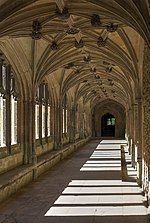History of Lacock
Commons category link is the pagenameEngvarB from September 2013Histories of populated places in EnglandHistory of WiltshireOpenDomesday

Lacock, England was first mentioned in the Domesday Book in 1086 with a population of less than 200, two small mills and a vineyard. The village's main attraction, Lacock Abbey, was founded on the manorial lands by Ela, Countess of Salisbury and established in 1232; in the reign of Henry III. Lacock was granted a market and developed a thriving wool industry during the Middle Ages. Reybridge, and a packhorse ford, remained the only crossing points of the River Avon until the 17th century.
Excerpt from the Wikipedia article History of Lacock (License: CC BY-SA 3.0, Authors, Images).History of Lacock
Hither Way,
Geographical coordinates (GPS) Address Nearby Places Show on map
Geographical coordinates (GPS)
| Latitude | Longitude |
|---|---|
| N 51.415 ° | E -2.117 ° |
Address
Hither Way
SN15 2LL , Lacock
England, United Kingdom
Open on Google Maps








